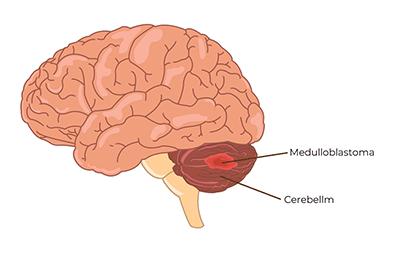Pediatric medulloblastoma (me·dul·lo·blas·to·ma) is a type of tumor that typically starts in the brain and can spread elsewhere in the brain and spinal cord. Children’s Health℠ offers state-of-the-art therapies to treat these cancers and a team of physicians – on the faculty at UT Southwestern Medical School – who work together to give your child the best opportunity to get back to normal childhood.
Overview
What is pediatric medulloblastoma?

Medulloblastoma develops from cells in the brain that are believed to be primitive nerve cells.
Medulloblastoma is the most common malignant brain tumor in children and only rarely affects adults.
Risk factors
Each year, around 600 children in the U.S. are diagnosed with this tumor. They are commonly diagnosed in children between the ages of 1 and 10 years.
Signs and Symptoms
What are the signs and symptoms of pediatric medulloblastoma?
Medulloblastomas can press into the brain or spinal cord, which can affect your child’s ability to think, move and do other tasks. These tumors can cause symptoms such as:
General weakness or lack of energy
Loss of balance or trouble walking
Trouble with handwriting or speech
Problems with coordination
Seizures
Unusual sleepiness
Weakness on one side of the face
Diagnosis
How is pediatric medulloblastoma diagnosed?
MRI - First, your child will have an MRI. This is a magnetic scan that allows us to locate the tumor (if there is one) and measure its size.
Biopsy - Next, we do a biopsy to relieve any pressure caused by the tumor and confirm the diagnosis of medulloblastoma.
Subtyping - We also routinely do subtyping of medulloblastomas. The different subtypes of medulloblastomas are treated differently with special drugs. Subtyping can help select the best treatment for your child.
Causes
What causes pediatric medulloblastoma?
The exact cause of medulloblastoma in most children is not known. Some children with medulloblastomas have a “genetic predisposition,” which means their genes put them at higher risk of developing this and related cancers. Since families share many of the same genes, other family members may also be at higher risk of certain cancers. If a genetic predisposition to cancer is found, we may recommend that parents and siblings have genetic testing.
Treatment
How is pediatric medulloblastoma treated?
We adjust our approach depending on your child’s age and their type of tumor. Treatments may include:
Surgery - We remove as much of the tumor as possible when we do the biopsy. This can reduce your child’s symptoms and give us a head start on treatment.
Radiation - For children age 3 or older, we can treat their tumor with radiation therapy. We offer both X-ray radiation and proton therapy, which is more precise and has fewer side effects. Radiation can cause problems for children under age 3, so we usually use different treatments for kids in that age group.
Chemotherapy - This involves using medicine to kill the cancer cells. Our team includes chemotherapy experts who know the right doses to destroy the cancer while keeping side effects to a minimum.
Targeted therapies - We can treat some types of medulloblastoma with specific drugs that target the genes that help those tumors grow. This may stop the tumor from getting bigger, shrink it or kill it all the way. Children's Health does a DNA test on all tumors, to see if a targeted therapy will work.
Doctors and Providers
We offer care from doctors and other specialists who focus specifically on brain tumors. Physicians practicing at Children’s Health are also on the faculty at UT Southwestern Medical Center and have seen more children with medulloblastoma than almost any other center in the region. Our experience and teamwork help us act quickly to treat your child’s cancer and reduce their pain and symptoms.
 Bradley Edward WeprinPediatric Neurosurgeon
Bradley Edward WeprinPediatric Neurosurgeon Daniel Charles BowersPediatric Hematologist/Oncologist
Daniel Charles BowersPediatric Hematologist/Oncologist Bruno BragaPediatric Neurosurgeon
Bruno BragaPediatric Neurosurgeon Kenneth ChenPediatric Hematologist/Oncologist
Kenneth ChenPediatric Hematologist/Oncologist Samuel JohnPediatric Hematologist/Oncologist
Samuel JohnPediatric Hematologist/Oncologist Laura Jean KlessePediatric Hematologist/Oncologist
Laura Jean KlessePediatric Hematologist/Oncologist Andrew Young KohPediatric Hematologist/Oncologist
Andrew Young KohPediatric Hematologist/Oncologist Patrick Joseph LeaveyPediatric Hematologist/Oncologist
Patrick Joseph LeaveyPediatric Hematologist/Oncologist Kathleen LudwigPediatric Hematologist/Oncologist
Kathleen LudwigPediatric Hematologist/Oncologist Angela Vivian PricePediatric Neurosurgeon
Angela Vivian PricePediatric Neurosurgeon Avanthi Tayi ShahPediatric Hematologist/Oncologist
Avanthi Tayi ShahPediatric Hematologist/Oncologist Ksenya ShliakhtsitsavaPediatric Hematologist/Oncologist
Ksenya ShliakhtsitsavaPediatric Hematologist/Oncologist Tiffany Renea Simms WaldripPediatric Hematologist/Oncologist
Tiffany Renea Simms WaldripPediatric Hematologist/Oncologist Tamra SlonePediatric Hematologist/Oncologist
Tamra SlonePediatric Hematologist/Oncologist Dale Matthew SwiftPediatric Neurosurgeon
Dale Matthew SwiftPediatric Neurosurgeon Tanya Carens WattPediatric Hematologist/Oncologist
Tanya Carens WattPediatric Hematologist/Oncologist Brett Anthony WhittemorePediatric Neurosurgeon
Brett Anthony WhittemorePediatric Neurosurgeon Jonathan Eric WickiserPediatric Hematologist/Oncologist
Jonathan Eric WickiserPediatric Hematologist/Oncologist Naomi Joan WinickPediatric Hematologist/Oncologist
Naomi Joan WinickPediatric Hematologist/Oncologist